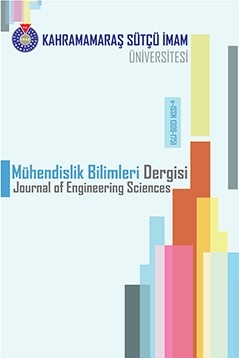KAHRAMANMARAŞ’IN BAZI MAHALLELERİNDE OLUŞAN ATIK PİL MİKTARLARININ BELİRLENMESİ
Atık piller; pillerin sınıflandırılması; atık pillerin dağılımı
DETERMINATION OF WASTE BATTERY QUANTITY IN SOME DISTRICTS OF KAHRAMANMARAS
___
- [1] Crompton, T.R. (2000) “Battery Reference Book, 3rd Ed.”, Reed Educational and Professional Publishing Ltd., Woburn. [2] Sayilgan, E., Kukrer, T., Civelekoglu, G., Ferella, F., Akcil, A., Veglio, F., Kitis, M. (2009) “A review of technologies for the recovery of metals from spent alkaline and zinc–carbon batteries”, Hydrometallurgy, 97, No. 3-4, p. 158. [3] Pistoia, G., Wiaux, J.P., Wolsky, S.P., (2001) “Used Battery Collection and Recycling”, Industrial Chemistry Library Vol. 10, Elsevier Science B.V., Amsterdam. [4] Bernardes, A.M., Espinosa, D.C.R., Tenório, J.A.S. (2004) “Recycling of batteries: a review of current processes and Technologies”, J. Power Sources, 130, No. 1-2, p. 291. [5] TUİK 2016 nüfus sayımı, http://www.tuik.gov.tr/PreIstatistikTablo.do?istab_id=1590, erişim tarihi: 25 Mart 2017. [6] Dolaz, M , Bozdoğan, N , Zıba, C . (2016). Kahramanmaraş Merkez İlçesi ve Bazı Mahallelerindeki Cam, Plastik ve Kağıt Atık Potansiyelinin Belirlenmesi. Kahramanmaraş Sütçü İmam Üniversitesi Mühendislik Bilimleri Dergisi, 19 (3), 68-75. [7] Linden, D., B. Reddy T. (2002) “Handbook of Batteries”, 3rd edition, McGraw-Hill, New York. [8] Pil türleri, https://en.wikipedia.org/wiki/List_of_battery_sizes, erişim tarihi: 20 Mart 2017. [9] TAP 2016 yılı verileri, http://tap.org.tr , erişim tarihi: 15 Mart 2016.
- Başlangıç: 1998
- Yayıncı: Kahramanmaraş Sütçü İmam Üniversitesi
Optimal Determination of Structural Dynamical Parameters Using Ambient Vibration
Mineral Katkılı Betonlarda Basınçlı Buhar Kürü Etkisinin Araştırılması
Kadir Güçlüer, Osman GÜNAYDIN, Abuzer ARIN
İki Enklüzyon ve Bir İç Çatlak İçeren Sonsuz Silindir
KAHRAMANMARAŞ’IN BAZI MAHALLELERİNDE OLUŞAN ATIK PİL MİKTARLARININ BELİRLENMESİ
Mehmet Hakan MORCALI, Bekir KARADENİZ
Peynir Üretiminde Yüksek Hidrostatik Basınç Uygulamaları
Şebekeden Bağımsız Bir PV Sistemin TRNSYS ile Gerçek Zamanlı Modellenmesi
